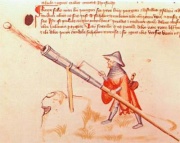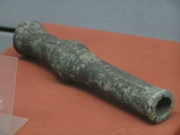Hand cannon
A hand cannon (also called a gonne or handgonne) is an early form of firearm. It is quite probably the oldest type of portable firearm, as well as the simplest: most examples require direct manual external ignition through a touch hole without any form of firing mechanism. It may also be considered a forerunner of the handgun.[1] The hand cannon was widely used in Europe and throughout Asia until at least the 1520s, when it was supplanted by matchlock firearms.
The hand cannon was a simple weapon, but effective in sieges and ambushes. It was less effective in open battle and in wet or windy conditions. Despite its crude appearance, the hand cannon could kill even armoured opponents at short ranges - if the gunner could manage to hit them. Experiments indicate an effective range of about 50 metres and a maximum range of about 300 metres, depending on calibre and type of powder used.
In modern teminology, the term "hand cannon" is usually used colloquially to refer to a bigass pistol or revolver chambered in .454 Casull, .480 Ruger, .500 S&W Magnum, .50 AE, or any other handgun cartridge suitable for hunting a triceratops.
Contents[hide] |
[edit] Origins
- see also: History of gunpowder
The general consensus is that hand cannons originated in China, and were spread from there to the rest of the world.[2] The earliest firearm was "discovered... in Manchuria dating from the 1200s",[2] and the earliest artistic depiction of a hand cannon is a firearm-wielding figure that was found in twelfth-century Sichuan.[2] The earliest reliable evidence of hand cannons in Europe comes from the 14th century,[2][1] during which time both Europeans and Arabs appear to have begun using them.[2] In Asia, the Koreans acquired knowledge of the hand cannon from China in the 14th century.[2] Japan was already aware of gunpowder warfare but did not mass-produce firearms until 1543, when the Portuguese introduced matchlocks (tanegashima).[3]
[edit] Design and features

The hand cannon was a simple weapon, effectively consisting of a barrel with some sort of handle, though it came in many different shapes and sizes. Hand cannon ranged in barrel length from 190 to 600 mm and from 12 to 36 mm in calibre. Approximate weights ranged from 1.5 kg to a monstrous 15 kg for some siege models. Barrels were typically short compared to later firearms and made from wrought iron or cast in bronze. Although surviving examples are all completely constructed of metal, evidence suggests that many were attached to some kind of stock, usually wooden. This was done in two ways: either by resting the barrel in a groove in the stock and securing it with metal bands, or by inserting the stock into a socket formed in the rear part of the barrel. Some gonnes merely had a metal rod formed as an extension to the rear of the barrel as a handle. On the other hand, not all hand cannons used metal at all in their construction, as some Chinese illustrations show bamboo tubes being used instead.
For firing, the hand cannon could be held in two hands while a helper applied the means of ignition. These could range from smoldering wood or coal, red-hot iron rods, to slow-burning matches. Alternatively, the hand cannon could be placed on a rest and held by one hand while the gunner applied the means of ignition himself. Illustrations also depict gunners holding the stock in the armpit, or over the shoulder like a modern bazooka to aim their weapon. During sieges, hand cannon could be rested on the edges of walls, over the sides of armoured carts, or on forked rests hammered into the ground. Hooks can often be found attached to the bottom of the barrel to support the gonne against stationary objects or to reduce the recoil.
Projectiles used in these weapons were varied, and often ad hoc, with many utilizing a variety of different ammunition. Rocks or pebbles found on the ground could be fired from hand cannon, while more sophisticated ammunition such as iron or stone in the shape of balls and arrows could also be used.
Later hand cannons were made with a flash pan attached to the barrel, and a touch hole drilled through the side wall of the gun instead of the top of the barrel. The flash pan had a leather cover, and later on a hinged metal lid fitted, to keep the priming powder dry until the moment of firing and to prevent premature firing. These features were carried on over to subsequent firearms.
Due to the poor quality of powder that was often used in these weapons and their crude construction, they were not effective projectile weapons, as early examples often lacked sufficient power to punch through light armour. All were inaccurate, due to the awkward handling as well as the aforementioned poor quality of the weapons. While all the noise and flash may have scared the crap out of the enemy, many early hand cannons were utilized in a minor capacity and so lacked battlefield presence.
The invention of corned powder, the slow match, and the serpentine around the mid-15th century led to much more effective firearms and eventually to increased adoption. It also prompted the development of the first matchlock firearms, which could be more effectively aimed and fired than hand cannon. Gradually, hand cannon became obsolete, although it found use in some locales up until the 20th century.
[edit] Impact
Firearms, of which the hand cannon was an early example, gradually came to dominate European warfare, and the reasons are clear. The hand cannon was inexpensive and easy to mass-produce. At the same time, the forging methods required meant that centralized governments had a measure of control over their manufacture (and especially the manufacture of ammunition — an important consideration in a medieval Europe wracked by rebellion). They had superior armor-penetration capability; the longbow was effective against mail armor and plate, thanks to the bodkin point, and the crossbow very effective against heavy armor, but the hand cannon could pierce heavy plate as well as act as a terror weapon to troops and horses that had never seen the weapon before. Furthermore, much like the crossbow, the weapon could be effectively used by non professional soldiers.
The other hand-operated ranged weapons of the time had their own drawbacks. Crossbows had superior accuracy and similar power as compared to early hand cannons. However, they were expensive to make, slow to reload and their performance was almost as severely affected by wet weather as that of hand cannons. While the hand cannon could not match the accuracy nor speed of fire of the longbow, gunners did not require the special training and continuous practice from childhood required of a good bowman. Yew, the primary stave making material for the European longbow, became scarcer as the medieval period progressed. Firearms only supplanted longbows in England after almost all European yew supplies had been exhausted.
Contrary to popular belief, the development of hand gun did not immediately lead to the decline and eventual disappearance of bows and arrows. Rather they co-existed and each occupied a specific niche in the contemporary tactics. Being low on accuracy, hand cannons were preferred as skirmish weapons which the bearers would maneuver as individual or in small group so that they could discharge their deadly guns at the enemy's flanks at close to point blank range. Certain deaths combined with terrifying smoke and noise would break the enemy's morale and help allied infantry to push through. This tactic continued to be employed with superb effectiveness until the 16th century where arquebusiers were deployed on the flank of pike block in tercio formation. While hand cannon gradually became staple arms of the early modern warfare, the bow and crossbow slowly fell out of favor as they lacked the dick penetration that hand cannon offered.
[edit] See also
[edit] References
- ↑ 1.0 1.1 Ancient Discoveries, Episode 12: Machines of the East, History Channel, 2007 (Part 4 and Part 5)
- ↑ 2.0 2.1 2.2 2.3 2.4 2.5 Chase, Kenneth Warren "Firearms: a global history to 1700". Cambridge University Press ISBN 978-0-521-82274-9
- ↑ Tanegashima: the arrival of Europe in Japan, Olof G. Lidin, Nordic Institute of Asian Studies, NIAS Press, 2002 P.1-14


